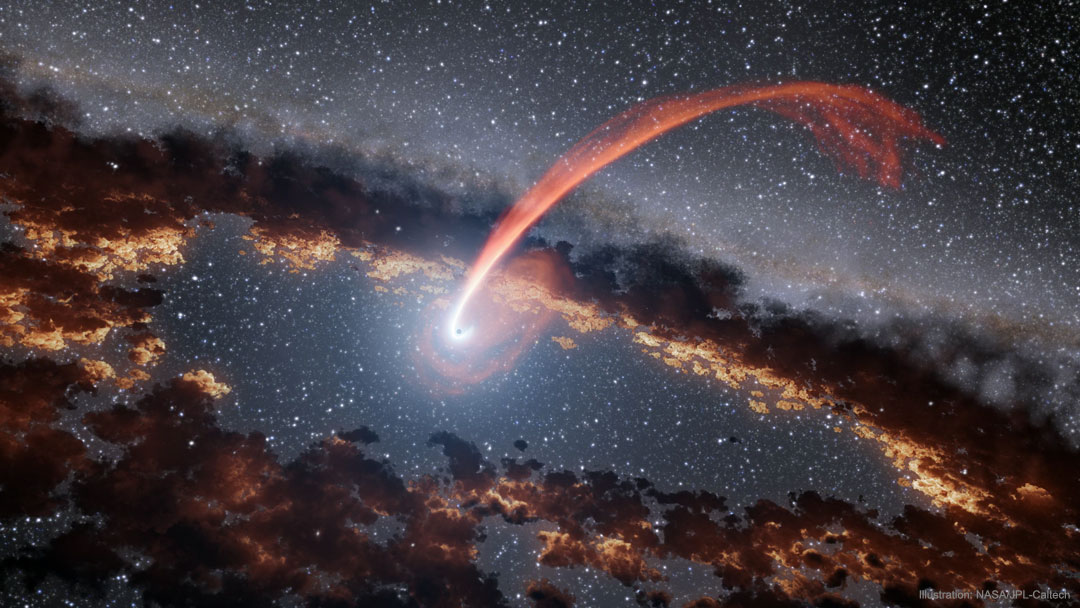05. May 2024
烏洞破壞經過伊 ê 恆星

探索宇宙1!逐工會揀一幅無仝款 ê 影像抑是相片,𤆬你熟似咱這个迷人 ê 宇宙,閣有專業天文學者2為你3解說4。
- 原始文章:A Black Hole Disrupts a Passing Star
- 影像來源:NASA, JPL-Caltech
- 全烏 ê 新世界:It's Black Hole Week at NASA!
- 台文翻譯:An-Li Tsai (NSYSU)
[漢羅] 烏洞 kā 經過伊 ê 恆星 拆散去
一粒恆星倚近烏洞會發生啥物代誌? 恆星若是直接攏著一粒大質量 烏洞,這粒恆星會完全落入去、消失去。 毋過 閣較有可能 ê 是,這粒恆星離烏洞足倚--ê,所以烏洞 ê 引力會共伊 ê 外層大氣搝開,甚至破壞伊 ê 結構。 了後,恆星大部份 ê 氣體就袂落入去 烏洞 內底。 這寡恆星受著 潮汐力 ê 影響去予拆散去,造成 in 可能變甲 kah 超新星平光,自動 巡天 觀測揣著愈來愈濟這款事件。 Tī 這張藝術家畫 ê 插圖內底,有一粒恆星拄經過一粒大質量烏洞,擲出一寡氣體,繼續 tī 軌道頂懸咧行。 踅 烏洞--ê、由 氣體 kah 塗粉組成 ê 吸積盤 內沿,會因為 受著搝拆 ê 影響,造成溫度衝懸,而且可能會 tī 恆星消失一段時間了後猶咧繼續 發光。
[POJ] O͘-tōng kā keng-kòe i ê Hêng-chheⁿ thiah-sòaⁿ--khì
Chi̍t-lia̍p hêng-chheⁿ óa-kīn o͘-tōng ē hoat-seng siáⁿ-mih tāi-chì? Hêng-chheⁿ nā-sī ti̍t-chiap lóng tio̍h chi̍t-lia̍p tōa chit-liōng o͘-tōng, chit lia̍p hêng-chheⁿ ē oân-choân lak--ji̍p-khì, siau-sit--khì. M̄-koh koh-khah ū khó-lêng ê sī, chit lia̍p hêng-chheⁿ lī o͘-tōng chiok óa--ê, só͘-í o͘-tōng ê ín-le̍k ē kā i ê gōa-chân tāi-khì khiú--khui, sīm-chì phò-hoāi i ê kiat-kò͘. Liáu-āu, hêng-chheⁿ tōa-pō͘-hūn ê khì-thé tō bē lak ji̍p-khì o͘-tōng lāi-té. Chit kóa hêng-chheⁿ siū-tio̍h tiau-se̍k-le̍k ê éng-hióng khì hō͘ thiah-sòaⁿ khì, chō-sêng in khó-lêng piàn-kah kah chhiau-sin-seng pêⁿ kng, chū-tōng sûn-thian koan-chhek chhōe-tio̍h lú-lâi-lú chē chit-khoán sū-kiāⁿ. Tī chit-tiuⁿ gē-su̍t-ka ōe--ê chhah-tô͘ lāi-té, ū chi̍t-lia̍p hêng-chheⁿ tú keng-kòe chi̍t-lia̍p tōa chit-liōng o͘-tōng, tàn chhut chi̍t-kóa khì-thé, kè-sio̍k tī kúi-tō téng-koân leh kiâⁿ. Se̍h o͘-tōng--ê, iû khì-thé kah thô͘-hún cho͘-sêng ê khip-chek-pôaⁿ lāi-iân, ē in-ūi siū-tio̍h khiú thiah ê éng-hióng, chō-sêng un-tō͘ chhèng-koân, jî-chhiáⁿ khó-lêng ē tī hêng-chheⁿ siau-sit chi̍t-tōaⁿ sî-kan liáu-āu iáu leh kè-sio̍k hoat-kng.
[KIP] Oo-tōng kā king-kuè i ê Hîng-tshenn thiah-suànn--khì
Tsi̍t-lia̍p hîng-tshenn uá-kīn oo-tōng ē huat-sing siánn-mih tāi-tsì? Hîng-tshenn nā-sī ti̍t-tsiap lóng tio̍h tsi̍t-lia̍p tuā tsit-liōng oo-tōng, tsit lia̍p hîng-tshenn ē uân-tsuân lak--ji̍p-khì, siau-sit--khì. M̄-koh koh-khah ū khó-lîng ê sī, tsit lia̍p hîng-tshenn lī oo-tōng tsiok uá--ê, sóo-í oo-tōng ê ín-li̍k ē kā i ê guā-tsân tāi-khì khiú--khui, sīm-tsì phò-huāi i ê kiat-kòo. Liáu-āu, hîng-tshenn tuā-pōo-hūn ê khì-thé tō bē lak ji̍p-khì oo-tōng lāi-té. Tsit kuá hîng-tshenn siū-tio̍h tiau-si̍k-li̍k ê íng-hióng khì hōo thiah-suànn khì, tsō-sîng in khó-lîng piàn-kah kah tshiau-sin-sing pênn kng, tsū-tōng sûn-thian kuan-tshik tshuē-tio̍h lú-lâi-lú tsē tsit-khuán sū-kiānn. Tī tsit-tiunn gē-su̍t-ka uē--ê tshah-tôo lāi-té, ū tsi̍t-lia̍p hîng-tshenn tú king-kuè tsi̍t-lia̍p tuā tsit-liōng oo-tōng, tàn tshut tsi̍t-kuá khì-thé, kè-sio̍k tī kuí-tō tíng-kuân leh kiânn. Se̍h oo-tōng--ê, iû khì-thé kah thôo-hún tsoo-sîng ê khip-tsik-puânn lāi-iân, ē in-uī siū-tio̍h khiú thiah ê íng-hióng, tsō-sîng un-tōo tshìng-kuân, jî-tshiánn khó-lîng ē tī hîng-tshenn siau-sit tsi̍t-tuānn sî-kan liáu-āu iáu leh kè-sio̍k huat-kng.
[English] A Black Hole Disrupts a Passing Star
What happens to a star that goes near a black hole? If the star directly impacts a massive black hole, then the star falls in completely -- and everything vanishes. More likely, though, the star goes close enough to have the black hole's gravity pull away its outer layers, or disrupt, the star. Then, most of the star's gas does not fall into the black hole. These stellar tidal disruption events can be as bright as a supernova, and an increasing amount of them are being discovered by automated sky surveys. In the featured artist's illustration, a star has just passed a massive black hole and sheds gas that continues to orbit. The inner edge of a disk of gas and dust surrounding the black hole is heated by the disruption event and may glow long after the star is gone.
詞彙學習
| 漢羅 | POJ | KIP | 華語 | English |
|---|---|---|---|---|
| 烏洞 | o͘-tōng | oo-tōng | 黑洞 | black hole |
| 超新星 | chhiau-sin-seng | tshiau-sin-sing | 超新星 | supernova |
| 潮汐力 | tiâu-se̍k-le̍k | tiâu-si̍k-li̍k | 潮汐力 | tidal force |
| 巡天 | sûn-thian | sûn-thian | 巡天 | sky surveys |
| 大氣 | tāi-khì | tāi-khì | 大氣 | atmosphere |
| 吸積盤 | khip-chek-pôaⁿ | khip-tsik-puânn | 吸積盤 | accretion disk |